White-washed houses in the middle of a spectacular landscape: The white villages of Andalusia are quite an eye-catcher from afar. Some of the most famous white villages in Andalusia are located along the Ruta de los Pueblos Blancos, the Route of the White Villages.
In this blog article, we will share with you the most beautiful spots along the Route of the White Villages, as well as which villages are particularly worth seeing and which highlights you absolutely should not miss. Here are our tips for your trip to the most beautiful pueblos blancos in Andalusia.
Inhalt
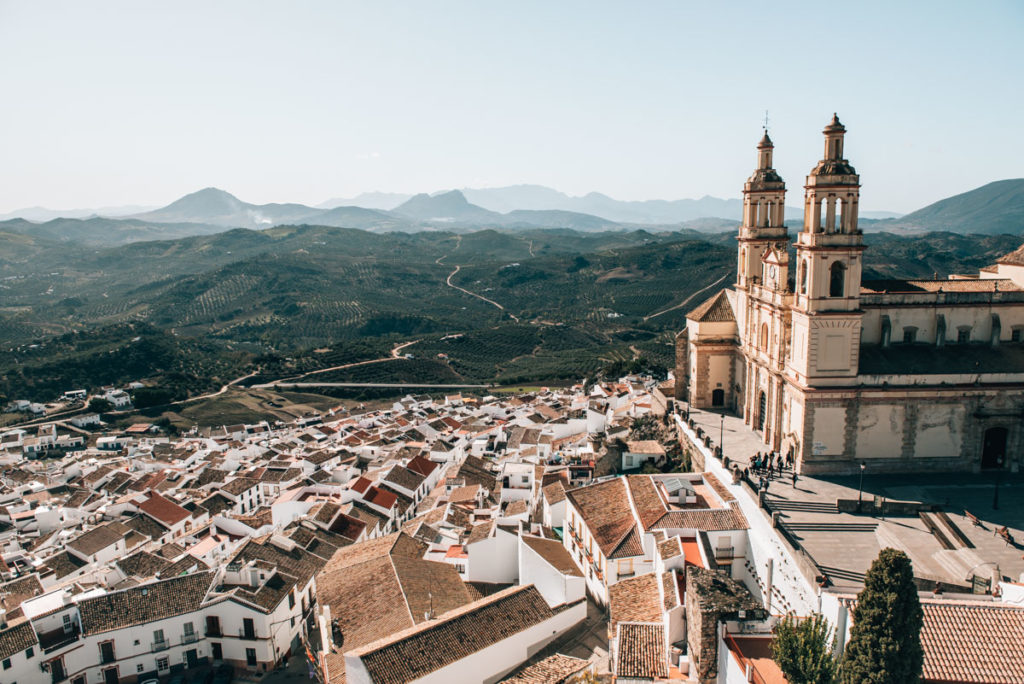
1. The White Villages of Andalusia: What to Expect?
The Andalusian postcard motif. Thanks to their bright house fronts, you can often see the white villages from afar. Many of them are located in the backcountry, almost perfectly embedded in the somewhat barren and rugged, beautiful landscape of Andalusia.
Most of the villages are many centuries old and date back to the Moorish times. The history of the villages can be felt immediately as you wander around the town centre. In the amidst the narrow, winding streets you immediately feel like you’ve been transported back in time.
What exactly are the White Towns of Andalusia?
You can find white villages all over Andalusia. However, some of the most beautiful and well-known are those of the “Ruta de los Pueblos Blancos” – aka. the “Route of the White Villages” in English. It winds through the mountainous backcountry of the Cadiz province in western Andalusia, especially through the Sierra de Grazalema nature park.
A total of 19 villages belong to the Ruta de los Pueblos Blancos. Oh and the famous town of Ronda is not officially one of them, by the way, but it’s very close. You will find a map overview at the end of the article that puts it all into perspective.
You shouldn’t think of the Route of the White Villages as a linear journey from A to B, because it also branches off in different directions. Depending on which villages interest you, you can put together your own personal itinerary for visiting these white villages.

How much time should I plan for the White Villages Road?
The Route of the White Villages is on the way from Málaga to Cadiz, in the mountainous backcountry of Andalusia. It will take you a good 5 hours for that route from Málaga to Cádiz. Therefore, one day is much too short if you really want to see this region.
Many of the villages can also be explored rather quickly and of course you can just do a short stopover, but we really don’t recommend it. Plus, you have Ronda in the same general direction, which you should also plan several hours for.
Our recommendation would be this: plan to stay at least one night, somewhere between Málaga and Cádiz. For example, you could stay in Ronda (coming from Málaga), which is at the beginning of the Route of the White Villages.
If you leave Ronda in the morning, you have a full day to drive to Cádiz (which takes a little less than 4 hours) so you have time to explore some of the White Villages on the way. Although you’ve still got a pretty full on day, it is definitely doable. If you want to take it easy, then we would suggest staying another night along the way.
Our hotel recommendation in Ronda: Catalonia Ronda


2. The Most Beautiful Stops Along the Route of the White Villages of Andalusia
In this section, we will tell you all about the white villages we visited in Andalusia, along the Ruta de los Pueblos Blancos on our way from Málaga to Cadiz. Therefore, the villages will be listed in that order – however, there is nothing wrong with doing it the other way round either.
Setenil de las Bodegas
The rock village of Setenil de las Bodegas is perhaps one of the most unique villages in this region. Unlike most white villages, it is not built on a hill, but in a kind of gorge. Many houses are built directly into the rocks – a truly surreal sight.
If you are looking for the most famous photo opportunities in Setenil de las Bodegas, then the best thing to do is to go down the streets of Cuevas del Sol and Cuevas de la Sombra. There are houses that are partially or even completely covered by rocks.
A stroll through the romantic Calle Herrería is also worthwhile. Lovers can take a picture of themselves at the photo spot there. You will recognise the photo spot by the sign (“Bésame en este rincón” – in English “kiss me in this corner”).
On another note, Setenil de las Bodegas was one of the most popular villages on our journey. Since it’s not very large, it starts to look crowded quite quickly. The best thing to do is to organise your visit to fall on a weekday, or come as early as possible.
Information about getting there and parking
From Ronda you can reach Setenil de las Bodegas in about 30 minutes. Good to know: Please don’t try to drive into the centre of Setenil de las Bodegas. The streets are incredibly narrow and you will struggle to find a parking space. However, you can park in the parking houses called Parking CP Plus. From there you can walk to the town centre in just a few minutes.



Olvera
Beautiful Olvera is one of our personal favourites. From afar, you can see the hill with the church and castle towering up – like a picture out of a fairytale.
The two most significant sights in Olvera are the parish church – Nuestra Señora de la Encarnación and the Arab fortress – Castillo de Olvera right next to it. If you head straight for the square in front of the church, you will be rewarded with a great view of the landscapes around Olvera. To top it off, the view from the Castillo de Olvera is one not-to-miss. There are some stairs leading you up to a kind of viewing platform from which you can look out in all directions. Admission to the Castillo is 2 Euros per person.
You also have a beautiful view of Olvera from the viewpoint at Monumento al Sagrado Corazón, which you can reach in just a few minutes via a staircase that starts at Plaza Andalucía.
Information about getting there and parking
From Setenil de las Bodegas, you can reach Olvera in about 25 minutes. Parking on the street seemed a little easier in Olvera than in other villages. However, we would not recommend driving too far into the historic centre, but park a few minutes out instead. We managed to find a free parking space in Calle Mercado quite easily.

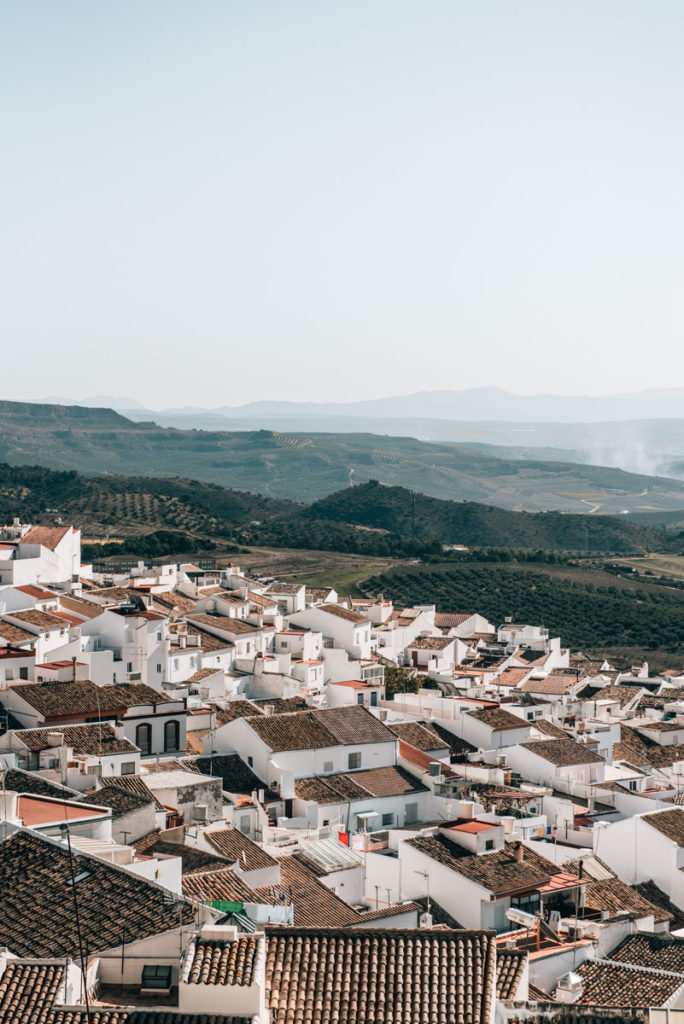



Zahara de la Sierra
Another postcard motif: Zahara de la Sierra is perched on a hill and situated by the dazzling blue reservoir – Embalse de Zahara-El Gastor. For many, Zahara de la Sierra is considered one of the most beautiful white villages in Andalusia.
The main attraction here is the Castillo de Zahara de la Sierra, which you can reach after a 15 minute mild steep climb. But the effort is totally worth the fantastic view that awaits you from the tower of the Castillo. Otherwise, the historic centre is also really worth seeing.
Information about getting there and parking
From Olvera to Zahara de la Sierra, it takes about 30 minutes. As you get closer, you have a wonderful view of Zahara de la Sierra from the road (A-2300), which runs directly along the lake shore for a short stretch. It looks like there is some kind of viewpoint there, but unfortunately without parking spaces.
To explore the city, you can park directly on the street in front of the entrance (on the CA-9104). For example, there are some parking spaces at the Mirador de Zahara de la Sierra and a little further up (at the level of the Al Lago restaurant). From there it is only a short walk uphill to the town centre.




Grazalema
This white village nestles almost perfectly on the hills of the Sierra de Grazalema mountain region. Grazalema is also considered one of the most beautiful villages in Andalusia – and rightly so, we think. Interesting fact: Apparently this region experiences the highest rainfall in all of Spain, and the landscape is respectively, much less barren than in most other places.
In Grazalema, you can look forward to exploring a very pretty historical town centre. If you head straight for the main square, the Plaza de España, you will find the most famous building in Grazalema, the Nuestra Señora de la Aurora church. It dates back to the 18th century.
Information about getting there and parking
The route from Zahara de la Sierra to Grazalema is probably the most spectacular of the entire journey. We would have loved to stop every hundred meters or so, just to take photos. The CA-9104 highway is the route we would recommend as it takes you in zig-zags up to the Puerto de las Palomas pass. From there it goes downhill again to Grazalema.
You have a beautiful view of Grazalema right at the entrance to the town. On Google Maps, the view is called El Tajo. There is a parking lot right next to it, where you can park your car and explore the town centre on foot.


Arcos de la Frontera
Arcos de la Frontera is not only one of the most famous white villages in the province of Cadiz, but also the western entrance to the White Villages Route. It is the closest village to Cádiz, at just 45 minutes away by car.
Although the landscape here is no longer as spectacular as it was before, Arcos de la Frontera is very impressively situated, enthroned on a steep sloping rock.
From the parking lot (which will we mention more below), you can reach the Plaza del Cabildo, the most important square in the old town of Arcos de la Frontera, with just a 10-15 minute walk. The parked cars unfortunately tarnish the otherwise beautiful picture-perfect scene. The plaza also has a small lookout point and the most important church in Arcos, the Basílica de Santa María de la Asunción. In addition, there is the Castillo de Arcos, which unfortunately cannot be visited.
If you walk further east from the Plaza Cabildo through the town centre, you will reach the viewpoint Mirador de Abades.
Information about getting there and parking
From Grazalema you can reach Arcos de la Frontera in about an hour. The first part of the route to El Bosque continues through the spectacular Sierra de Grazalema Nature Park. This stretch of the journey offers some fantastic views.
You can park your car in the underground car park at Plaza España. From there you can reach the historic centre on foot in just a few minutes. The alleyways in the centre are often terribly narrow, so we would not recommend you drive in by car.



3. Tips for Booking Rental Cars in Andalusia
One thing is certain: exploring these white villages without a car is almost impossible (or would be very cumbersome if you tried). Therefore, we rented a car for our entire trip in Andalusia.
As with all our trips, we booked the car through Sunny Cars. Sunny Cars acts as an intermediary and comparison platform. This basically means that Sunny Cars compares the offers for you and you book directly on the Sunny Cars website. When it comes to pick up, you simply go to one of the local car rental companies. (For us it was Europcar, but it varies across the board.)
The big advantage of Sunny Cars is that: You have full comprehensive insurance and in the event of any damage, Sunny Cars will reimburse you in full. In a country like Spain, where the locals are not exactly known for their ‘held-back’ driving style, this is quite a reassurance. If something happens, you are on the safe side – regardless of whether you are to blame or not.
You can search for cheap rental cars here: Sunny Cars
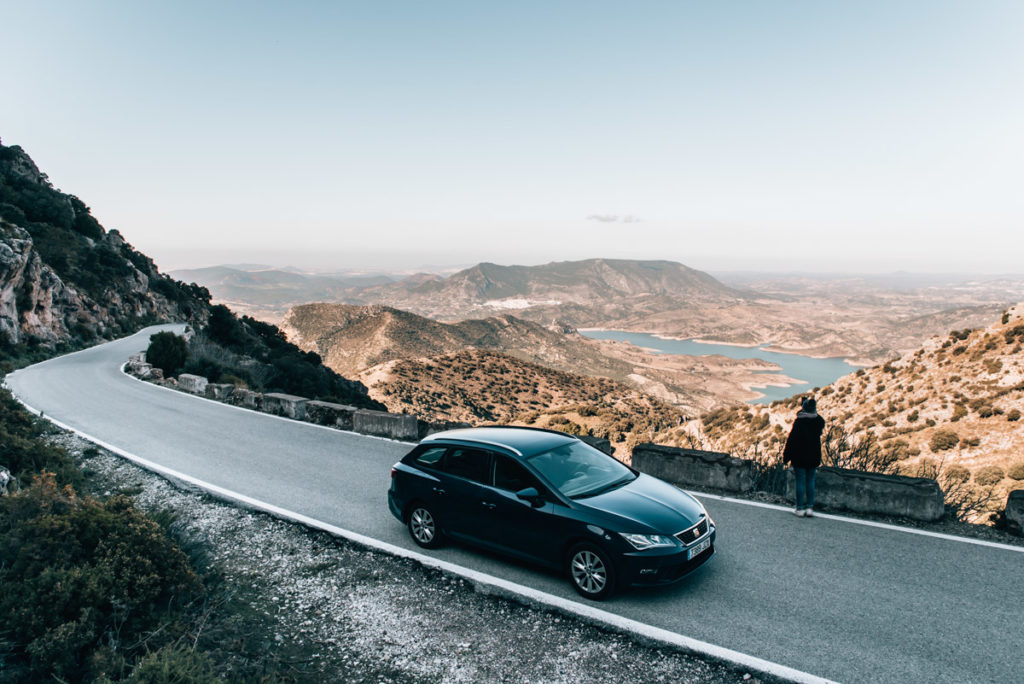
4. Map Overview of the White Towns of Andalusia
In this map we have pinned all the stops that we made along the White Towns of Andalusia. The route will definitely take you to some of the most beautiful white villages in Spain.
If you have more time, you might consider taking a detour from Grazalema via the A-374 to Ubrique. This section of the route is supposedly said to be very spectacular, but unfortunately we didn’t have time for it on the day we visited.
Disclaimer: Affiliate Links
This blog article contains our personal recommendations in the form of affiliate links. If you book or buy something through these links, then we will receive a small commission from the company. But this does not change the price for you at all. We appreciate it so very much!
Have you ever been to the White Towns of Andalusia? If so, which one of the white villages was your favourite? Let us know your experiences and tips in the comments below, we look forward to reading them!
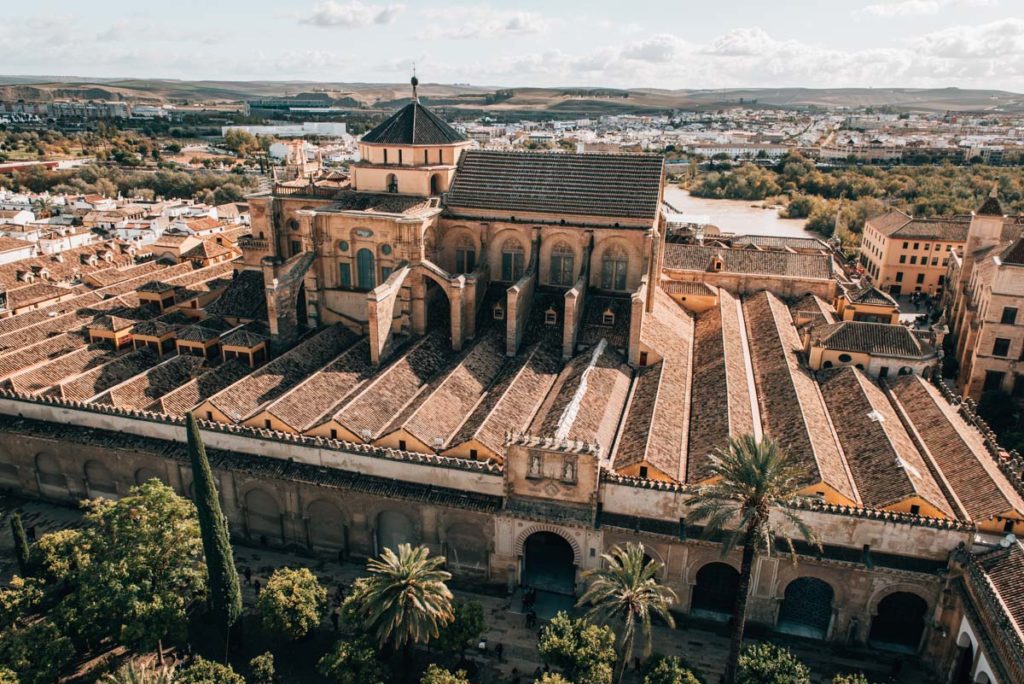
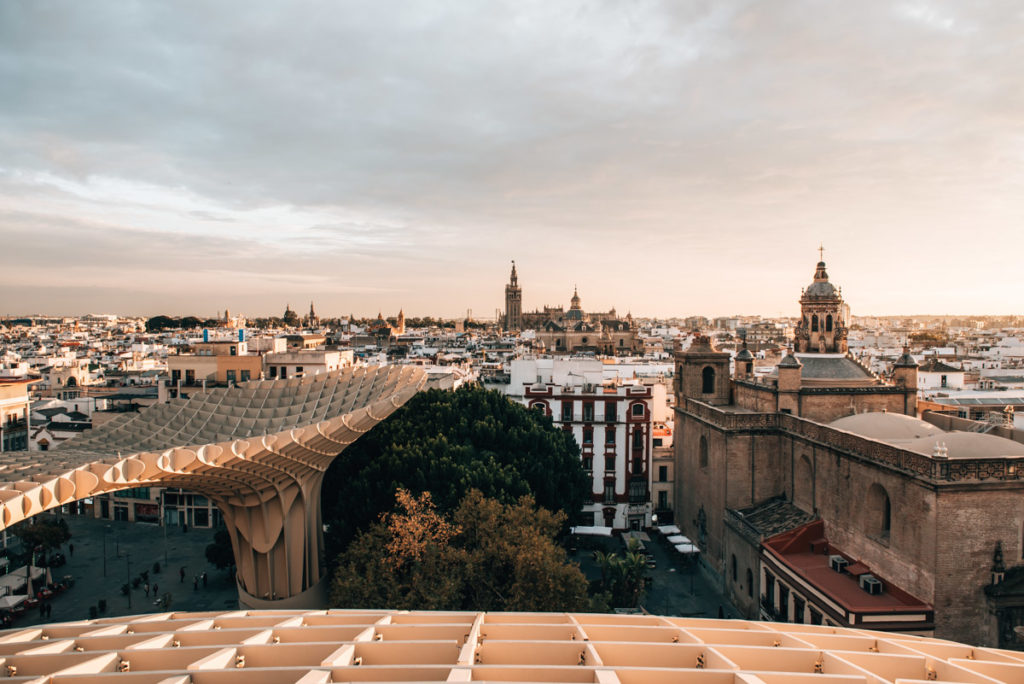
Hello! Just wanted to say thank you for this blog post. My wife and I are spending a month in Seville while I work remotely. We took a road trip over the weekend and followed your guide to the White Villages of Andalusia, except we did them in reverse order. We hit every stop except Olvera (ran out of time before sundown). It was a very scenic ride and your tips on parking, etc helped greatly! We finished with a nice dinner in Rhonda (where we have visited previously) before driving back to Seville. For others, I concur that this trip would be better with an overnight, especially if you haven’t visited Rhonda before as that would take at least half a day on its own.
Hi Peter,
Thank you so much for your message – we really appreciate it! :)
So glad you had a great time in Andalusia! All the best from Vienna,
Kathi & Romeo